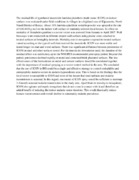| dc.contributor.author | Mulambalah, Chrispinus S. | |
| dc.contributor.author | Siamba, Donald N. | |
| dc.contributor.author | Ngeiywa, Moses M. | |
| dc.contributor.author | Vulule, John M. | |
| dc.date.accessioned | 2019-05-13T12:21:01Z | |
| dc.date.available | 2019-05-13T12:21:01Z | |
| dc.date.issued | 2011 | |
| dc.identifier.issn | 1815-8846 | |
| dc.identifier.uri | http://docsdrive.com/.../258-263.pdf | |
| dc.identifier.uri | http://erepository.kibu.ac.ke/handle/123456789/941 | |
| dc.description.abstract | The residual life of pyrethroid insecticide lambdacyhalothrin (trade name: ICON) on indoor surfaces was evaluated under field conditions in villages in a highland area of Kipsamoite, North Nandi District of Kenya. About 10% lambda-cyhalthrin wettable powder was sprayed at the rate of 0.02-0.03 g m-2 on the indoor wall surface of randomly selected local houses. Its effect on mortality of Anopheles gambiae s.s as test vector was assessed from January to April 2007. Wall bioassays were conducted on different treated wall surfaces using plastic cones attached to treated surfaces at fortnightly intervals. Mortality rate in mosquitoes exposed to treated surfaces varied according to the type of wall that received the insecticide. ICON was more stable and lasted longer on mud and wood surfaces. There was significant difference between persistence of ICON on mud and other surfaces tested. For the insecticide formulation used, the duration of the residual effect was satisfactory up to the WHOPES recommended post spray period. Beyond this period, persistence declined rapidly on metal and cemented/brick plastered surfaces. The low effectiveness of the formulation on metal and cement surfaces should be considered together with the importance of residual spraying as a vector control method in the area. We concluded that the use of ICON in IRS could be a single and effective strategy to control endophiliic and antropophilic malaria vectors in malaria hypoendemic area. This is based on the findings that the local vector is susceptible to ICON and most of the houses had mud surfaces and malaria transmission is seasonal. In this regard, one round of ICON spray would be sufficient to interrupt 3-4 month seasonal malaria transmission in the study area. Apart from its toxicity to mosquitoes, ICON also agitates and repels mosquitoes that do not come in contact with it and therefore an added benefit of reducing the indoor malaria vector densities. This would drastically reduce human-vector contact and overall decline in community malaria prevalence. | en_US |
| dc.language.iso | en | en_US |
| dc.publisher | Oxford university press | en_US |
| dc.rights | Attribution-NonCommercial-ShareAlike 3.0 United States | * |
| dc.rights.uri | http://creativecommons.org/licenses/by-nc-sa/3.0/us/ | * |
| dc.title | Targeted indoor insecticide and malaria control in the western highlands Kenya. | en_US |
| dc.type | Article | en_US |

